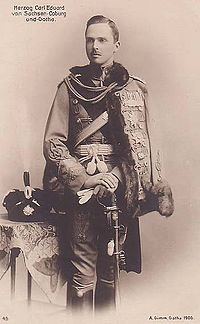Creation date 24 May 1881 First holder Prince Leopold | ||
 | ||
Remainder to the 1st Duke's heirs male of the body lawfully begotten | ||
The duke of albany jacob de haan
Duke of Albany (Scottish Gaelic: Diùc na h-Alba) was a peerage title that has occasionally been bestowed on the younger sons in the Scottish and later the British royal family, particularly in the Houses of Stuart and Windsor.
Contents
- The duke of albany jacob de haan
- History
- Dukes of Albany first creation 1398
- Dukes of Albany second creation 1458
- Duke of Albany 1541
- Dukes of Albany third creation 1565
- Duke of Albany fourth creation 1604
- Duke of Albany fifth creation 1660
- Duchess of Albany Jacobite Peerage 1783 or earlier
- Dukes of Albany sixth creation 1881
- Dukes of Albany in fiction
- References
History
The Dukedom of Albany was first granted in 1398 by King Robert III of Scotland on his brother, Robert Stewart, the title being in the Peerage of Scotland. "Albany" was a broad territorial term representing the parts of Scotland north of the River Forth, roughly the former Kingdom of the Picts. The title (along with the Dukedom of Rothesay) was the first Dukedom created in Scotland. It passed to Robert's son Murdoch Stewart, and was forfeited in 1425 due to the attainder of Murdoch.
The title was again created in 1458 for Alexander Stewart but was forfeit in 1483. His son John Stewart, was restored to the second creation in 1515 but died without heirs in 1536. In 1541 Robert, second son of James V of Scotland, was styled Duke of Albany, but he died at less than a month old. The fourth creation, along with the Earldom of Ross and Lordship Ardmannoch, was for Mary, Queen of Scots' king consort Lord Darnley, whose son, later James VI of Scotland, I of England and Ireland, inherited the titles on his death. That creation merged with the Scottish crown upon James's ascension. The title, along with the title of Duke of York, with which it has since been traditionally coupled, was created for a fifth time in 1604 for Charles, son of James VI and I. Upon Charles's ascent to the throne in 1625, the title of Duke of Albany merged once again in the crowns.
The title was next granted in 1660 to Charles I's son, James, by Charles II. When James succeeded his elder brother to the throne in 1685, the titles again merged into the crown. The cities of New York and Albany, New York were thus both named after James, as he was the Duke of York and of Albany. The pretender, Charles Edward Stuart, gave the title Duchess of Albany to his illegitimate daughter Charlotte; she died in 1789.
The title "Duke of York and Albany" was granted three times by the Hanoverian kings.
The title of "Albany" alone was granted for the fifth time, this time in the Peerage of the United Kingdom, in 1881 to Prince Leopold, the fourth son of Queen Victoria. Prince Leopold's son, Prince Charles Edward (who had succeeded as reigning Duke of Saxe-Coburg and Gotha in 1900), was deprived of the peerage in 1919 for bearing arms against the United Kingdom in World War I. Under the Titles Deprivation Act 1917, the legitimate lineal male heir of the 1st Duke of Albany was allowed to petition the British Crown for the restoration of the peerages. Because subsequent descendants have married in contravention of the Royal Marriages Act 1772, there were no people alive who can make such a petition. The last person eligible to do so was Friedrich Josias, Prince of Saxe-Coburg and Gotha, who died in 1998. So prior to 2013,the marriages of the male descendants of the 2nd Duke were invalid in the UK. However the Succession to the Crown Act 2013 specified otherwise in section 3(5).
